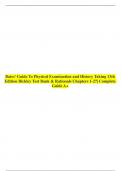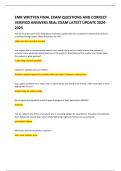Bates’ Guide To Physical Examination and History Taking 13th
Edition Bickley Test Bank & Rationals Chapters 1-27| Complete
Guide A+
,CHAPTER 1 Foundations for Clinical Proficiency
ULTIPLE CHOICE
1. After copleting an initial assessent of a patient, the nurse has charted that his respirations
are eupneic and his pulse is 58 beats per inute. These types of data would be:
a Objective.
.
b Reflective.
.
c Subjective.
.
d Introspective.
.
ANS: A
Objective data are what the health professional observes by inspecting, percussing, palpating,
and auscultating during the physical exaination. Subjective data is what the person says about
hi or herself during history taking. The ters reflective and introspective are not used to
describe data.
DIF: Cognitive Level: Understanding (Coprehension) REF: p. 2
SC: Client Needs: Safe and Effective Care Environent: anageent of Care
2. A patient tells the nurse that he is very nervous, is nauseated, and feels hot. These types of
data would be:
a Objective.
.
b Reflective.
.
c Subjective.
.
d Introspective.
.
ANS: C
Subjective data are what the person says about hi or herself during history taking. Objective
data are what the health professional observes by inspecting, percussing, palpating, and
auscultating during the physical exaination. The ters reflective and introspective are not used
,to describe data.
DIF: Cognitive Level: Understanding (Coprehension) REF: p. 2
SC: Client Needs: Safe and Effective Care Environent: anageent of Care
3. The patients record, laboratory studies, objective data, and subjective data cobine to for
the:
a Data base.
.
b Aditting data.
.
c Financial stateent.
.
d Discharge suary.
.
ANS: A
Together with the patients record and laboratory studies, the objective and subjective data for
the data base. The other ites are not part of the patients record, laboratory studies, or data.
DIF: Cognitive Level: Reebering (Knowledge) REF: p. 2
SC: Client Needs: Safe and Effective Care Environent: anageent of Care
4. When listening to a patients breath sounds, the nurse is unsure of a sound that is heard. The
nurses next action should be to:
a Iediately notify the patients physician.
.
b Docuent the sound exactly as it was heard.
.
c Validate the data by asking a coworker to listen to the breath sounds.
.
d Assess again in 20 inutes to note whether the sound is still present.
.
ANS: C
When unsure of a sound heard while listening to a patients breath sounds, the nurse validates the
data to ensure accuracy. If the nurse has less experience in an area, then he or she asks an expert
to listen.
DIF: Cognitive Level: Analyzing (Analysis) REF: p. 2
SC: Client Needs: Safe and Effective Care Environent: anageent of Care
,5. The nurse is conducting a class for new graduate nurses. During the teaching session, the
nurse should keep in ind that novice nurses, without a background of skills and experience
fro which to draw, are ore likely to ake their decisions using:
a Intuition.
.
b A set of rules.
.
c Articles in journals.
.
d Advice fro supervisors.
.
ANS: B
Novice nurses operate fro a set of defined, structured rules. The expert practitioner uses
intuitive links.
DIF: Cognitive Level: Understanding (Coprehension) REF: p. 3
SC: Client Needs: General
6. Expert nurses learn to attend to a pattern of assessent data and act without consciously
labeling it. These responses are referred to as:
a Intuition.
.
b The nursing process.
.
c Clinical knowledge.
.
d Diagnostic reasoning.
.
ANS: A
Intuition is characterized by pattern recognitionexpert nurses learn to attend to a pattern of
assessent data and act without consciously labeling it. The other options are not correct.
DIF: Cognitive Level: Understanding (Coprehension) REF: p. 4
SC: Client Needs: General
7. The nurse is reviewing inforation about evidence-based practice (EBP). Which stateent
best reflects EBP?
, a EBP relies on tradition for support of best practices.
.
b EBP is siply the use of best practice techniques for the treatent of patients.
.
c EBP ephasizes the use of best evidence with the clinicians experience.
.
d The patients own preferences are not iportant with EBP.
.
ANS: C
EBP is a systeatic approach to practice that ephasizes the use of best evidence in cobination
with the clinicians experience, as well as patient preferences and values, when aking decisions
about care and treatent. EBP is ore than siply using the best practice techniques to treat
patients, and questioning tradition is iportant when no copelling and supportive research
evidence exists.
DIF: Cognitive Level: Applying (Application) REF: p. 5
SC: Client Needs: Safe and Effective Care Environent: anageent of Care
8. The nurse is conducting a class on priority setting for a group of new graduate nurses. Which
is an exaple of a first-level priority proble?
a Patient with postoperative pain
.
b Newly diagnosed patient with diabetes who needs diabetic teaching
.
c Individual with a sall laceration on the sole of the foot
.
d Individual with shortness of breath and respiratory distress
.
ANS: D
First-level priority probles are those that are eergent, life threatening, and iediate (e.g.,
establishing an airway, supporting breathing, aintaining circulation, onitoring abnoral vital
signs) (see Table 1-1).
DIF: Cognitive Level: Understanding (Coprehension) REF: p. 4
SC: Client Needs: Safe and Effective Care Environent: anageent of Care
9. When considering priority setting of probles, the nurse keeps in ind that second-level
priority probles include which of these aspects?
, a Low self-estee
.
b Lack of knowledge
.
c Abnoral laboratory values
.
d Severely abnoral vital signs
.
ANS: C
Second-level priority probles are those that require propt intervention to forestall further
deterioration (e.g., ental status change, acute pain, abnoral laboratory values, risks to safety
or security) (see Table 1-1).
DIF: Cognitive Level: Understanding (Coprehension) REF: p. 4
SC: Client Needs: Safe and Effective Care Environent: anageent of Care
10. Which critical thinking skill helps the nurse see relationships aong the data?
a Validation
.
b Clustering related cues
.
c Identifying gaps in data
.
d Distinguishing relevant fro irrelevant
.
ANS: B
Clustering related cues helps the nurse see relationships aong the data.
DIF: Cognitive Level: Understanding (Coprehension) REF: p. 2
SC: Client Needs: Safe and Effective Care Environent: anageent of Care
11. The nurse knows that developing appropriate nursing interventions for a patient relies on the
appropriateness of the diagnosis.
a Nursing
.
b edical
.
, c Adission
.
d Collaborative
.
ANS: A
An accurate nursing diagnosis provides the basis for the selection of nursing interventions to
achieve outcoes for which the nurse is accountable. The other ites do not contribute to the
developent of appropriate nursing interventions.
DIF: Cognitive Level: Understanding (Coprehension) REF: p. 6
SC: Client Needs: Safe and Effective Care Environent: anageent of Care
12. The nursing process is a sequential ethod of proble solving that nurses use and includes
which steps?
a Assessent, treatent, planning, evaluation, discharge, and follow-up
.
b Adission, assessent, diagnosis, treatent, and discharge planning
.
c Adission, diagnosis, treatent, evaluation, and discharge planning
.
d Assessent, diagnosis, outcoe identification, planning, ipleentation, and
. evaluation
ANS: D
The nursing process is a ethod of proble solving that includes assessent, diagnosis,
outcoe identification, planning, ipleentation, and evaluation.
DIF: Cognitive Level: Understanding (Coprehension) REF: p. 3
SC: Client Needs: Safe and Effective Care Environent: anageent of Care
13. A newly aditted patient is in acute pain, has not been sleeping well lately, and is having
difficulty breathing. How should the nurse prioritize these probles?
a Breathing, pain, and sleep
.
b Breathing, sleep, and pain
.
c Sleep, breathing, and pain
.
, d Sleep, pain, and breathing
.
ANS: A
First-level priority probles are iediate priorities, reebering the ABCs (airway, breathing,
and circulation), followed by second-level probles, and then third-level probles.
DIF: Cognitive Level: Analyzing (Analysis) REF: p. 4
SC: Client Needs: Safe and Effective Care Environent: anageent of Care
14. Which of these would be forulated by a nurse using diagnostic reasoning?
a Nursing diagnosis
.
b edical diagnosis
.
c Diagnostic hypothesis
.
d Diagnostic assessent
.
ANS: C
Diagnostic reasoning calls for the nurse to forulate a diagnostic hypothesis; the nursing process
calls for a nursing diagnosis.
DIF: Cognitive Level: Understanding (Coprehension) REF: p. 2
SC: Client Needs: General
15. Barriers to incorporating EBP include:
a Nurses lack of research skills in evaluating the quality of research studies.
.
b Lack of significant research studies.
.
c Insufficient clinical skills of nurses.
.
d Inadequate physical assessent skills.
.
ANS: A
As individuals, nurses lack research skills in evaluating the quality of research studies, are
isolated fro other colleagues who are knowledgeable in research, and often lack the tie to
visit the library to read research. The other responses are not considered barriers.
,DIF: Cognitive Level: Understanding (Coprehension) REF: p. 6
SC: Client Needs: General
16. What step of the nursing process includes data collection by health history, physical
exaination, and interview?
a Planning
.
b Diagnosis
.
c Evaluation
.
d Assessent
.
ANS: D
Data collection, including perforing the health history, physical exaination, and interview, is
the assessent step of the nursing process (see Figure 1-2).
DIF: Cognitive Level: Reebering (Knowledge) REF: p. 2
SC: Client Needs: General
17. During a staff eeting, nurses discuss the probles with accessing research studies to
incorporate evidence-based clinical decision aking into their practice. Which suggestion by the
nurse anager would best help these probles?
a For a coittee to conduct research studies.
.
b Post published research studies on the units bulletin boards.
.
c Encourage the nurses to visit the library to review studies.
.
d Teach the nurses how to conduct electronic searches for research studies.
.
ANS: D
Facilitating support for EBP would include teaching the nurses how to conduct electronic
searches; tie to visit the library ay not be available for any nurses. Actually conducting
research studies ay be helpful in the long-run but not an iediate solution to reviewing
existing research.
DIF: Cognitive Level: Applying (Application) REF: p. 6
, SC: Client Needs: Safe and Effective Care Environent: anageent of Care
18. When reviewing the concepts of health, the nurse recalls that the coponents of holistic
health include which of these?
a Disease originates fro the external environent.
.
b The individual huan is a closed syste.
.
c Nurses are responsible for a patients health state.
.
d Holistic health views the ind, body, and spirit as interdependent.
.
ANS: D
Consideration of the whole person is the essence of holistic health, which views the ind, body,
and spirit as interdependent. The basis of disease originates fro both the external environent
and fro within the person. Both the individual huan and the external environent are open
systes, continually changing and adapting, and each person is responsible for his or her own
personal health state.
DIF: Cognitive Level: Understanding (Coprehension) REF: p. 7
SC: Client Needs: Safe and Effective Care Environent: anageent of Care
19. The nurse recognizes that the concept of prevention in describing health is essential because:
a Disease can be prevented by treating the external environent.
.
b The ajority of deaths aong Aericans under age 65 years are not
. preventable.
c Prevention places the ephasis on the link between health and personal
. behavior.
d The eans to prevention is through treatent provided by priary health care
. practitioners.
ANS: C
A natural progression to prevention rounds out the present concept of health. Guidelines to
prevention place the ephasis on the link between health and personal behavior.
DIF: Cognitive Level: Understanding (Coprehension) REF: p. 7
SC: Client Needs: General
20. The nurse is perforing a physical assessent on a newly aditted patient. An exaple of
objective inforation obtained during the physical assessent includes the:





